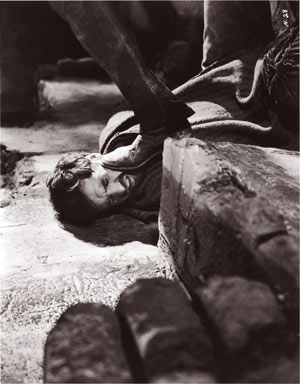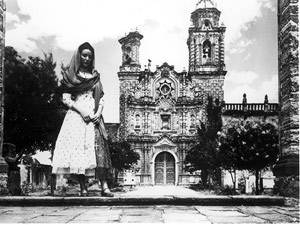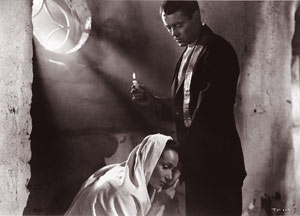 |
 |
 |

 |
|
Dates: Friday and Saturday, January 11, and 12, 2008, with a special encore presentation of two films on Sunday, March 9, 2008
Location: Getty Center, Harold M. Williams Auditorium
Admission: Free; a separate reservation is required for each film.
This series features three films by Gabriel Figueroa, the preeminent cinematographer of Mexico's Golden Age of Film (1930–1960).
Figueroa was a masterful artist whose images cast an indelible view of a Mexico that was stunning but at the same time harsh and lonely. In tandem with the best of the era's directors, particularly Emilio "El Indio" Fernández (director of Enamorada, screening on Saturday evening), Figueroa established a visual identity for Mexico that is prevalent to this day.
This series complements the exhibition The Goat's Dance: Photographs by Graciela Iturbide, on view December 18, 2007–April 13, 2008 at the Getty Center.
|
 |

|

 |
 |
 |
|
Friday, January 11, 2008, 7:30 p.m., and Sunday, March 9, 2008, 1:00 p.m.
Based on the novel by Benito Peréz Galdós
(1958, Luis Buñuel, 35mm, 94 min., in Spanish with English subtitles)
Nazarín was one of Buñuel's most deeply ambivalent films. Pope John Paul II included it in his list of the 45 best films of all time, while film critic Leonard Maltin deemed it "one of Buñuel's harshest critiques of Christianity." Set in the Mexico of Porfirio Diaz, the film centers on Don Nazario, a "Quixote of the priesthood," whose obsessive devotion to Christian ideals results in calamity for himself and those around him. Eventually defrocked, he sets out on a journey through the countryside with a local prostitute and her sex-starved sister. While Nazario is adamant in his desire to "accept suffering with resignation," Buñuel leaves viewers in doubt as to whether the priest should be seen as a saintly fool or a kind of spiritual masochist. The film's ambiguity is heightened by Figuero's fluid camera, which hovers gently but precariously around the characters, often seeming to anticipate their actions and even their thoughts.
|
 |


|

 |
 |
 |
 |
|
Saturday, January 12, 2008, 7:30 p.m., and Sunday, March 9, 2008, 3:30 p.m.
(Mexico, 1946, Emilio Fernández, 35mm, 99 min., in Spanish with English subtitles)
A fusion of tearjerker, screwball comedy, and national foundation myth, Enamorada transposes Shakespeare's The Taming of the Shrew to a small Puebla town during the anti-clerical Juarez Revolution. In the film, the liberal General Reyes (Pedro Armendáriz) falls for Beatriz (Maria Félix), the hotheaded daughter of the town's wealthiest reactionary. Though the film is concerned with religion, Figueroa's camera especially worships the ravishing Félix—whether she's clasping a mammoth pistol, smoking a long black cigarillo, or exploding a firecracker under the general's horse. Meanwhile, the love-struck Reyes grows increasingly more gentle and teary-eyed. Critics have suggested that Fernández's true aim for the film was a mythic reformulation of national gender archetypes, a vision of a new Mexico where virile women fight for justice alongside heroically sensitive men.
|
 |


|

 |
 |
 |
 |
|
Saturday, January 12, 2008, 4:00 p.m.
Based on the novel The Power and the Glory by Graham Greene
(1947, John Ford, 35mm, 104 min., in English)
Director John Ford took Graham Greene's greatest novel, The Power and the Glory, and created a poetic art film, one he claimed was his favorite. Under the Production Code, it became necessary to soften Greene's pious though flawed "whiskey priest" (played in the film by Henry Fonda), so that pride in martyrdom was his greatest foible. The film caused a rift between Ford and screenwriter Nichols, who claimed that Ford tossed the script out somewhere in Cuernevaca. While important traces of Nichols's dialogue remained, the film's most resonant feature is Figueroa's photography. Greatly undervalued, the film is a quiet, measured, and beautiful look at a harsh episode in Mexican history seen through the eyes of two masterful visual storytellers.
|
 |


|

 |

How to Get Here
The Getty Center is located at 1200 Getty Center Drive in Los Angeles, California, approximately 12 miles northwest of downtown Los Angeles. See Hours, Directions, Parking for maps and driving directions.
|
 |
 |
 |
Event Information by E-Mail
Be the first to know about upcoming lectures, concerts, and exhibitions by signing up for our free e-newsletters. Learn more and sign up now. |

Film stills from Nazarín and The Fugitive are courtesy of the Academy of Motion Picture Arts and Sciences.
Text adapted from program notes by Andrea Alsberg and Theresa Schwartzman of the UCLA Film and Television Archive |
 |
 |




